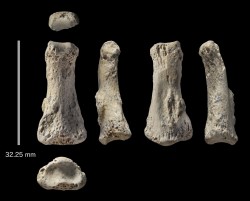The oldest directly dated modern human fossil found outside of Africa and the Levant
The work published today in Nature Ecology and Evolution is led by Dr Huw Groucutt from the University of Oxford and the Max Planck Institute for the Science of Human History, and involved an international team from Saudi Arabia, including the Saudi Commission for Tourism and National Heritage and the Saudi Geological Survey, the United Kingdom, Germany, Spain and Australia. Archaeological surveys and excavations at Al Wusta were performed within the framework of the international Palaeodeserts research project led by Professor Michael Petraglia from the Max Planck Institute for the Science of Human History. They yielded numerous animal fossils, including hippopotamus and tiny fresh water snails, associated with abundant lithic tools made by humans. Among these finds was a well preserved and small fossil human finger bone (AW-1). Further analyses performed in the laboratory showed that the fossil could only come from our species, Homo sapiens. Using a technique called uranium series dating, this fossil was found to be 90,000 years old. This result makes the finger bone the oldest directly dated human fossil found outside of Africa and the Levant. To confirm this age, other dating methods were applied to different materials found in association with the human fossil, such as the Optically Stimulated Luminescence (OSL) dating of quartz grains and the Electron Spin Resonance (ESR) dating of a hippopotamus tooth. The latter was performed at the Centro Nacional de Investigación sobre la Evolución Humana (CENIEH, Burgos, Spain) by Mathieu Duval from the Australian Research Centre for Human Evolution at Griffith University, and has received financial support from the European Union (Marie Curie International Outgoing Fellowship PIOF-GA-2013-626474) and the Australian Research Council (FT150100215). Finally, in-depth environmental analyses revealed the site was once a freshwater lake in an ancient grassland environment far removed from today’s desert conditions. This new discovery confirms that early dispersals of Homo sapiens out of Africa were more spatially and temporally extensive than previously thought. It is consistent with the recent discovery of a modern human maxilla at Mislyia cave that has been published a few months ago in the journal Science (https://www.cordis.europa.eu/news/rcn/142156_en.html). Reference Groucutt, H.S. Rainer Grün, Iyad S.A. Zalmout, Nick A. Drake, Simon J. Armitage, Ian Candy, Richard Clark-Wilson, Julien Louys, Paul S. Breeze, M. Duval, Laura T. Buck, Tracy L. Kivell, Emma Pomeroy, Nicholas B. Stephens, Jay T. Stock, Mathew Stewart, Gilbert J. Price, Leslie Kinsley, Wing Wai Sung, Abdullah Alsharekh, Abdulaziz Al-Omari, Muhammad Zahir, Abdullah M. Memesh, Ammar J. Abdulshakoor, Abdu M. Al-Masari, Ahmed A. Bahameem, Khaled S.M. Al Murayyi, Badr Zahrani, Eleanor M.L. Scerri & Michael D. Petraglia. Homo sapiens in Arabia by 85,000 years ago. Nature Ecology & Evolution. DOI: 10.1038/s41559-018-0518-2.
Keywords
Human evolution, Homo sapiens, direct dating of fossil, finger bone, Saudi Arabia
Countries
Spain



